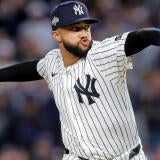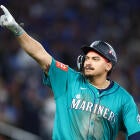Projecting AL shortstops with RC/27
Where did all of the shortstops in the American League disappear to? Our Al Melchior examines the position using RC/27 and says there just aren't any elite options to consider on Draft Day heading into 2009.
At no position in either league is the talent thinner than at shortstop in the American League. Not so long ago, Derek Jeter and Michael Young towered over other American League shortstops, making them a must-pick early in AL-only drafts. Their productivity has fallen hard over the last couple of seasons, and meanwhile, Jhonny Peralta, Mike Aviles and a crew of up-and-comers have risen to their level. The elite National League trio of Hanley Ramirez, Jose B. Reyes and Jimmy Rollins are still hot commodities in mixed-league drafts, but for owners in AL-only leagues, there is such parity at the shortstop position, that there is no need to take any shortstop prior to the fifth round. Waiting might mean that you miss out on Jeter or Young, but the dropoff to a lower-rung shortstop like Yuniesky Betancourt is not nearly as great as the amount of productivity you would lose by waiting to fill a spot at another position.
The Elite: Simply put, there is no elite among AL shortstops anymore. There are 10 teams in the AL that are set with their starting shortstop for the coming year. If we exclude the White Sox, since Alexei Ramirez does not qualify at shortstop to start the season, that leaves us with nine shortstops who are locks to play regularly. Of these nine, seven project to compile an RC/27 somewhere between 4.0 and 5.0. In other words, AL regular shortstops are relatively interchangeable. Once Ramirez becomes eligible at short, he becomes the default elite AL shortstop, with a projected RC/27 in the 5.0 to 5.5 range.
Solid Mixed Leaguers: While AL shortstops are bunched closer together than players at other positions, there are still a cluster of four who stand out among the rest: Jeter, Peralta, Young and Aviles. Of this group, Aviles is the most suspect, since he looks even more ordinary if we wipe out his 2008 stats from Kansas City and Triple-A Omaha. If he can somehow find regular at-bats, possibly as the Rays' right fielder, Ben Zobrist possesses the combination of power and on-base skills to keep pace with any shortstop in the league. Given his uncertain status, he remains a last resort in mixed leagues. Likewise, owners have to monitor Jed Lowrie's battle with Julio Lugo, as well as Erick Aybar's and Brandon Wood's battle with each other and Maicer Izturis, before dedicating a mixed league roster spot to any of them. Adding to the depth of this tier, we could slot Orlando Cabrera into the 4.5 to 5.0 RC/27 category if he lands with an AL team.
Cohort Analysis: Derek Jeter vs. Jhonny Peralta vs. Michael Young. Jeter's declining power not only means the possible demise of his status as a double-digit homer guy, but the end of his days as a .300 hitter. The only category where he has a clear edge over both Peralta and Young is in stolen bases, and even that is by default. Young does everything just well enough to hang with the best AL shortstops, but doesn't perform well enough in any category to stand out. That leaves Peralta, whose whiff rate and Isolated Power have improved dramatically over the last two seasons. He will still strike out more than Jeter or Young, so he'll lose the battle for batting average, but he has closed that gap enough to make his growing advantage in homers and RBI really count. That makes Peralta the No. 1 AL shortstop, just ahead of Jeter and Young.
Cohort Analysis, Part II: Jed Lowrie vs. Brendan Harris. Both Lowrie and Harris may have to split playing time, though Lowrie has fewer competitors in his way. Lowrie may also be viewed as the better hitter for average, and be due for a rise to the .290s level he achieved in the minors in '07. Beware his .258 rookie average, which was actually boosted by a .342 BABIP. Lowrie has a long way to go to prove he can hit for average in the big leagues, and he and Harris look like approximate equals in the other categories. Unless there is reason to believe that Harris will suffer a significant drop in playing time, he deserves to be taken before Lowrie.
|
|
||||
| Player | 2009 projection | 2008 | 2007 | 2006 |
| Ben Zobrist | 5.0-5.5 | 6.09 | N/A | 2.56 |
| Mike Aviles | 5.0-5.5 | 6.02 | N/A | N/A |
| Derek Jeter | 5.0-5.5 | 4.99 | 6.28 | 8.19 |
| Jhonny Peralta | 5.0-5.5 | 4.96 | 5.08 | 4.02 |
| Michael Young | 5.0-5.5 | 4.82 | 5.47 | 5.56 |
| Jed Lowrie | 4.5-5.0 | 4.62 | N/A | N/A |
| Erick Aybar | 4.5-5.0 | 4.41 | 2.24 | N/A |
| Brendan Harris | 4.5-5.0 | 4.25 | 4.93 | N/A |
| Brandon Wood | 4.5-5.0 | 2.31 | N/A | N/A |
AL-Only Leaguers: Jason Bartlett, Yuniesky Betancourt and Cesar Izturis will be handed the keys to starting jobs, but none should find their way into your mixed league starting lineup, as each is a one-category wonder. Speedster Elvis Andrus is the frontrunner to be the starter in Texas, but a potentially low batting average could threaten your Fantasy team's production, if not his role as a regular. All of the others on this list represent reasonable uses of an AL-only roster spot if they can find close-to-regular at-bats.
Cohort Analysis: Jason Bartlett vs. Yuniesky Betancourt. Bartlett has outproduced Betancourt in each of the last three seasons, at least as RC/27 tells the story, so is there any reason to consider ranking Betancourt ahead of Bartlett? There is one: Betancourt's whiff rate has declined in each of his big league seasons, while Bartlett's has been growing. That trend could widen the gap between their batting averages to 20 points or more, which in turn could widen their RBI gap. The only category where Bartlett has a clear advantage is stolen bases, but his edge of 10 to 15 swipes is probably not enough to make up for the growing deficits in other categories.
|
|
||||
| Player | 2009 projection | 2008 | 2007 | 2006 |
| Marco Scutaro | 4.0-4.5 | 4.48 | 3.91 | 4.59 |
| Jason Bartlett | 4.0-4.5 | 4.27 | 4.67 | 5.25 |
| Maicer Izturis | 4.0-4.5 | 4.16 | 5.40 | 5.47 |
| Julio Lugo | 4.0-4.5 | 3.89 | 3.65 | 5.01 |
| Yuniesky Betancourt | 4.0-4.5 | 3.54 | 4.38 | 4.20 |
| Nick Punto | 3.5-4.0 | 4.47 | 2.75 | 4.85 |
| Cesar Izturis | 3.5-4.0 | 3.72 | 3.14 | 2.88 |
| Elvis Andrus | 3.5-4.0 | N/A | N/A | N/A |
| Brent Lillibridge | 3.5-4.0 | N/A | N/A | N/A |
The Rest: Bobby Crosby and Adam Everett will provide more at-bats than several of the players on the AL-Only Leaguers list, but their lack of productivity could leave you worse off than if you took a potential part-timer like Aybar or Lugo. All three players on this list are worst-case endgame options, but if you have to gamble on one, Crosby is the best choice. Double-digit homers and steals are a possibility, though bear in mind that he has never accomplished both in the same season, and he has hit above .240 just once.
|
|
||||
| Player | 2009 projection | 2008 | 2007 | 2006 |
| Bobby Crosby | 3.0-3.5 | 3.28 | 3.00 | 3.30 |
| Adam Everett | 3.0-3.5 | 3.17 | 3.02 | 3.43 |
| John McDonald | 2.5-3.0 | 2.24 | 3.13 | 2.59 |
|
|
|
Runs Created per 27 Outs (RC/27) -- An estimate of how many
runs a lineup would produce per 27 outs if a particular player
occupied each spot in the order; ex. the RC/27 for Miguel Cabrera
would predict the productivity of a lineup where Cabrera (or his
statistical equal) batted in all nine spots; created by Bill James Component ERA (ERC) -- An estimate of a what a pitcher's ERA would be if it were based solely on actual pitching performance; created by Bill James Base Hits per Balls in Play (BABIP) -- The percentage of balls in play (at bats minus strikeouts and home runs) that are base hits; research by Voros McCracken and others has established that this rate is largely random and has a norm of approximately 30% Isolated Power -- The difference between slugging percentage and batting average; created by Branch Rickey and Allan Roth Walk Rate -- Walks / (at bats + walks) Whiff Rate -- Strikeouts / at bats |
Al Melchior was recently a Fantasy columnist and data analyst for Baseball HQ and will be providing advice columns for CBSSports.com. Click here to send him a question. Please put "Melchior" in the subject field.
















